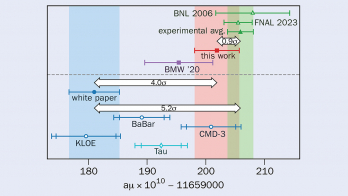by Steven Weinberg, Cambridge University Press. Hardback ISBN 052182351X, £18.95 ($25).
I have been an admirer of this book since its first edition 20 years ago, and have recommended it on many courses for the general public, where people might be making their first encounter not only with particle physics but with physics itself. In my opinion that is the great strength of Weinberg’s book: it sets the discoveries of the first subatomic particles – the electron, proton and neutron – against a background of experimentation in physics, explaining in simple terms how we know that this is the way that matter is.
The electron, the longest- and best-known of subatomic particles, takes up the first half of the book, which is enriched by “flashbacks” to discuss topics such as energy and electric and magnetic forces. These subjects may be the bread-and-butter of the physicist’s world, but they are often less than obvious to most other people, who left these ideas behind when they left school. By presenting such concepts in an historical manner, Weinberg allows the reader to learn in a way that mirrors how the physicists of the 18th and 19th centuries themselves learned.
The members of the subatomic “zoo” discovered in the second half of the 20th century – from neutrinos to gluons – are covered in 10 or so pages at the end of the book. As Weinberg points out, it was not his intention to write another popular book on modern physics, and nowadays there are other books that readers can pick up once they have read Weinberg’s. This revised edition, however, brings the section on the modern particles up to date, and Weinberg has also taken the opportunity to point out the links between the historic discoveries and the work of particle physics today. I’m pleased the book is back in print and shall certainly continue to recommend it.









